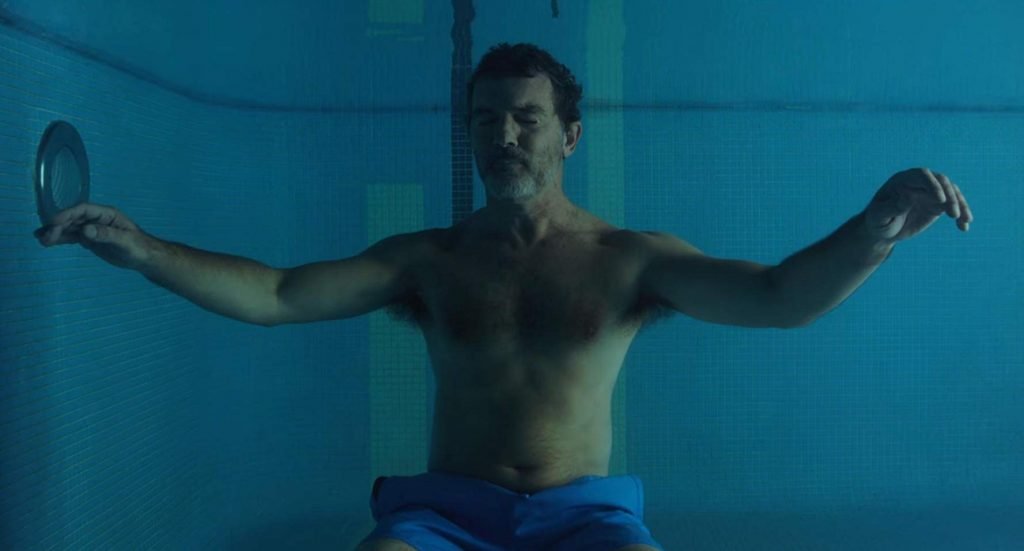Almodóvar’s Pain and Glory is a poetical speculation on self, memory, and the art of filmmaking that will make you will scream for more. Art cinema has never been so mouthwatering!
Underwater crying is no self-evident business. So, as Pedro Almodóvar’s Pain and Glory (Dolor Y Gloria) opens with tears magically rolling out of Antonio Banderas’s eyes and hovering over his soaking-wet cheekbones, we feel magic happening already. The Spanish filmmaker certainly has never been the first advocate for stark-naked realism. And we all remember the endearing & wildly unabashed pop yet Goyaesque esthétique that films such as Bad Education (2004) and I’m So Excited (2013) gracefully forced into the realm of contemporary Spanish cinema. Nevertheless, we can immediately taste a whole new kind of dreaminess in Pain and Glory. Something we perceive, at the same time, as both familiar and taste bud-dazzling.
The secret of it all might lie in a reverse-Proustian association laying siege to our brain cells. At first sight, Pain and Glory has in fact the distinctive appearance of a treatise about memory, time past, and lost opportunities. Following middle-aged director Salvador Mallo (played by Banderas)’s excruciatingly painful soul routine, Almodóvar seems to be spinning a tale of artistic atonement and forgiveness. We understand Mallo has been plodding through a massive writer’s block; we meet his family during childhood flashbacks; we see him reconciliate with actor friend Alberto (Asier Etxeandia) – by this time we are more than pondering on what Banderas’s character sexual taste might be like. We nicely line up ideas in our minds, and we take a good close look at every detail on screen. We think we know where the story is heading. In a Proustian way, we are just waiting for the next madeleine to come up and solve the puzzle of Mallo’s soul.
That’s when Almodóvar breaks every wave and turns every scene into a wonderfully unsparing X-ray painting of Mallo’s present self as man more than artist. That’s when an unexpected filter is pulled over facts as we thought we knew them, revealing sombrely blazing colours and nuances that breathe new life into the classic portrait of the artist as a tormented being. And that’s beautiful.

Everything in Pain and Glory is so movingly beautiful that it almost hurts not to be able to share the characters’ lives with them. But seamless editing techniques and an aesthetic – not aestheticizing – attitude towards inanimate objects and living bodies come across as mere counterpoints to Banderas’s quietly impassioned performance and composer Antonio Iglesias’s Debussyesque atmospheric music score. The private reveries of a stuck man thus become poem-like speculations about what is and what could have been, conferring upon beloved Almodóvarian (anti-)realism the relatable flavour of life lived first-hand and retrospectively enjoyed as a kind of addictive drug.
As stated by one of the characters in the film, once you’ve chosen your path, the only thing to do is stepping forward with crossed fingers, knowing that the best you’ll be able to do is repeating yourself until you get corny and people start losing their interest in you. Well, Almodóvar might have chosen to be a film director and tell tales of people that live with other people and basically do nothing the rest of the time. Still, what he couldn’t have predicted in the long run was that he was going to be able to always reinvent his style and never steer-wheel the death trap of I’ve-already-seen-it-all cinema. That’s for us to subscribe to.
And I hereby subscribe to the widespread belief that Pedro Almodóvar Caballero is one of the finest filmmakers our age has witnessed so far, and that his Pain and Glory gives ultimate proof of that. When shown a film of such alluring grace and stimulating meta-reflection, numbering yourself among a vast crowd of overexcited admirers is nothing but a pleasure. And just as Almodóvar never takes too much pain in wording the meaning of his films – I can’t really explain this in another words. At the end of the day, everything boils down to the story we tell, mostly to ourselves. And stories make up our reality, and who we think we are. Take, for instance, Pain and Glory’s very last scene, where the camera pulls out and reveals someone holding a microphone over…
Pain and Glory is now available to watch on digital and on demand.

